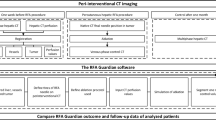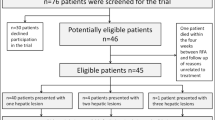Abstract
In the last few years, radiofrequency ablation has become one of the most promising techniques to treat liver tumors. But radiologists have to face the difficulty of planning their treatment while only relying on 2D slices. We present here a realistic radiofrequency ablation simulation tool, coupled with a 3D reconstruction and visualization project. They help radiologists to have a better visualization of patients anatomic structures and pathologies, and allow them to easily find an adequate treatment.
Access this chapter
Tax calculation will be finalised at checkout
Purchases are for personal use only
Preview
Unable to display preview. Download preview PDF.
Similar content being viewed by others
References
McGahan J.F., Dodd III G.D.: Radiofrequency ablation of the liver: Current status. American Journal of Roentgenology 176(1) (2001) 3–16
Cady B., Jenkins R.L., Steele G.D. Jr, et al.: Surgical margin in hepatic resection for colorectal metastasis: a critical and improvable determinant of outcome. Annals of Surgery 227 (1998) 566–571
Soler L., Delingette H., Malandain G., Montagnat J., Ayache N., Koehl C., Dourthe O., Malassagne B., Smith M., Mutter D. and Marescaux J.: Fully automatic anatomical, pathological, and functional segmentation from CT scans for hepatic surgery. Computer Aided Surgery 6(3) (2001) 131–142
Goldberg S.N.: Radiofrequency tumor ablation: principles and techniques. European Journal of Ultrasound 13(2) (2001) 129–147
De Baere T., Denys A., Wood B.J., Lassau N., Kardache M., Vilgrain V., Menu Y., Roche A.: Radiofrequency liver ablation: Experimental comparative study of watercooled versus expandable systems. American Journal of Roentgenology 176(1) (2001) 187–192
Rossi S., Garbagnati F., Lencinoni R.: Unresectable hepatocellular carcinoma: percutaneous radiofrequency thermal ablation after occlusion of tumor blood supply. Radiology 217 (2000) 119–126
Livraghi T., Goldberg S.N., Monti F., et al.: Saline-enhanced radiofrequency tissue ablation in the treatment of liver metastasis. Radiology 202 (1997) 205–210
Livraghi T., Goldberg S.N., Lazzaroni S., Meloni F., Solbiati L. and G. Scott Gazelle: Small Hepatocellular Carcinoma: Treatment with Radio-frequency Ablation versus Ethanol Injection. Radiology 210(3) (1999) 655–661
Rewcastle J.C., Sandison G.A., Kennedy P., Donnelly B.J., Saliken J.C.: 3-Dimensional visualization of Simulated Prostate Cryosurgery. Society of Cardiovascular and Interventional Radiology 25th Annual Meeting, San Diego, California (March 25–30, 2001)
Butz T., Warfield S.K., Tuncali K., Silverman S.G., van Sonnenberg E., Jolesz F.A. and Kikinis R.: Pre-and Intra-operative Planning and Simulation of Percutaneous Tumor Ablation. Medical Image Computing and Computer Assisted Intervention, Pittsburgh, USA. (Oct. 2000) 317–326
Tungjitkusolmun S., Staelin S., Haemmerich D., Cao H., Tsai J.-Z., Cao H., Webster J.G., Lee F.T., Mahvi D.M., Vorperian V.R.: Three-dimensional finite element analyses for radio-frequency hepatic tumor ablation. IEEE Trans. Biomed. Eng. 49(2) (2002) 3–9
Sandison G.A. and Rewcastle J.C.: Optimized Treatment Planning for Cryotherapy. Medical and Biological Engineering and Computing 35 Supplement Part 2 (1997) p 708
Serra J.: Image Analysis and Mathematical Morphology. Ac. Press, Tome 1 (1982)
Author information
Authors and Affiliations
Editor information
Editors and Affiliations
Rights and permissions
Copyright information
© 2003 Springer-Verlag Berlin Heidelberg
About this paper
Cite this paper
Villard, C. et al. (2003). Virtual Radiofrequency Ablation of Liver Tumors. In: Ayache, N., Delingette, H. (eds) Surgery Simulation and Soft Tissue Modeling. IS4TM 2003. Lecture Notes in Computer Science, vol 2673. Springer, Berlin, Heidelberg. https://doi.org/10.1007/3-540-45015-7_35
Download citation
DOI: https://doi.org/10.1007/3-540-45015-7_35
Published:
Publisher Name: Springer, Berlin, Heidelberg
Print ISBN: 978-3-540-40439-2
Online ISBN: 978-3-540-45015-3
eBook Packages: Springer Book Archive




